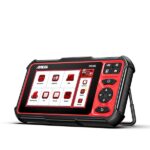The BlueDriver OBD2 scanner is a popular tool in the automotive DIY and professional mechanic communities. Known for its user-friendly interface and Bluetooth connectivity, it offers a way to access your vehicle’s diagnostic data using your smartphone. But how exactly do you use the BlueDriver OBD2 scanner, and is it the right choice for your needs? This guide will walk you through using the BlueDriver, explore its features, and compare it to alternatives.
Understanding the BlueDriver OBD2 Scanner
BlueDriver sets itself apart by using a dedicated app that communicates with its OBD2 connector via Bluetooth. This wireless connection provides convenience and allows for real-time data monitoring and diagnostics. Unlike some generic OBD2 scanners, BlueDriver is often praised for its comprehensive vehicle coverage and the depth of diagnostic information it provides. It’s primarily designed as a scan and diagnostics tool, focusing on reading and clearing trouble codes, accessing live data, and performing advanced diagnostics.
Step-by-Step Guide: How to Use BlueDriver OBD2
Using the BlueDriver OBD2 scanner is straightforward. Here’s a step-by-step guide to get you started:
-
Download and Install the BlueDriver App: The first step is to download the BlueDriver app on your smartphone or tablet. The app is available for both iOS and Android devices.
-
Plug in the BlueDriver OBD2 Connector: Locate the OBD2 port in your vehicle. This port is typically found under the dashboard on the driver’s side. Plug the BlueDriver connector securely into the OBD2 port.
-
Pair via Bluetooth: Enable Bluetooth on your smartphone or tablet. Open the BlueDriver app and follow the on-screen instructions to pair your device with the BlueDriver connector. The app will guide you through the pairing process, usually involving selecting the BlueDriver device from the list of available Bluetooth devices.
-
Start Your Vehicle: Turn your vehicle’s ignition to the “ON” position or start the engine. This provides power to the OBD2 port and the BlueDriver scanner.
-
Run a Scan: In the BlueDriver app, navigate to the “Scan” or “Diagnostics” section. Initiate a vehicle scan. The BlueDriver will communicate with your vehicle’s computer system to retrieve diagnostic trouble codes (DTCs) and other relevant data.
-
Review Diagnostic Information: Once the scan is complete, the app will display any detected DTCs along with descriptions and possible causes. BlueDriver often provides repair information and potential fixes, which is a valuable feature for DIYers.
-
Access Live Data and Other Features: Beyond basic code reading, the BlueDriver app allows you to access live engine data, perform mode 6 diagnostics, and generate vehicle-specific repair reports. Explore the app’s menu to discover the full range of features available for your vehicle.
-
Clear Trouble Codes (If Necessary): If you have addressed the issue causing a DTC, you can use the BlueDriver app to clear the trouble code and turn off the check engine light. However, it’s crucial to understand the root cause of the problem before clearing codes to prevent recurrence.
BlueDriver Features and Benefits
BlueDriver offers several features that make it a compelling OBD2 scan tool:
- User-Friendly App: The intuitive mobile app is a significant advantage, making it easy for both beginners and experienced users to navigate and understand diagnostic data.
- Comprehensive Diagnostics: BlueDriver goes beyond basic code reading, offering access to advanced diagnostics, including ABS, airbag, and other system scans, depending on vehicle compatibility.
- Repair Reports: A standout feature is the ability to generate vehicle-specific repair reports, providing potential causes and fixes for detected issues.
- Live Data Streaming: Monitor real-time engine parameters to diagnose performance issues and understand how your vehicle is operating.
- Bluetooth Connectivity: Wireless connection offers convenience and flexibility during diagnostics.
BlueDriver vs. Alternatives: Vgate iCar2 and Others
While BlueDriver is a solid OBD2 scanner, it’s worth considering alternatives like the Vgate iCar2, mentioned in the original text, and other generic ELM327-based scanners.
The Vgate iCar2, often used with apps like Bimmercode and Carista, offers versatility and compatibility with various apps via Wi-Fi or Bluetooth. It’s also generally more affordable than BlueDriver. Generic ELM327 scanners provide basic OBD2 functionality and are compatible with numerous third-party apps.
However, BlueDriver distinguishes itself with its dedicated app and potentially deeper diagnostic capabilities and repair information, which may justify its higher price point for users seeking a more integrated and feature-rich experience. The original text questions if BlueDriver’s connector is proprietary, suggesting it might only work with its own app. While physically it uses a standard OBD2 port, its functionality is indeed tightly integrated with the BlueDriver app, which is part of its user experience design.
Is BlueDriver OBD2 Worth It?
The value of BlueDriver OBD2 depends on your needs and budget. For users who prioritize ease of use, comprehensive diagnostics, and guided repair information within a dedicated app ecosystem, BlueDriver is a worthwhile investment. Its user-friendliness and features can save time and money on diagnostics and repairs, especially for DIY car enthusiasts and those wanting more than just basic code reading.
However, if you are comfortable using generic ELM327 scanners with third-party apps and are looking for a more budget-friendly option, or need coding capabilities, alternatives like Vgate iCar2 and other ELM327 adapters might be more suitable.
Ultimately, BlueDriver OBD2 is a powerful and user-friendly tool for vehicle diagnostics. Understanding how to use it and its features will help you make informed decisions about your car maintenance and repair needs.
